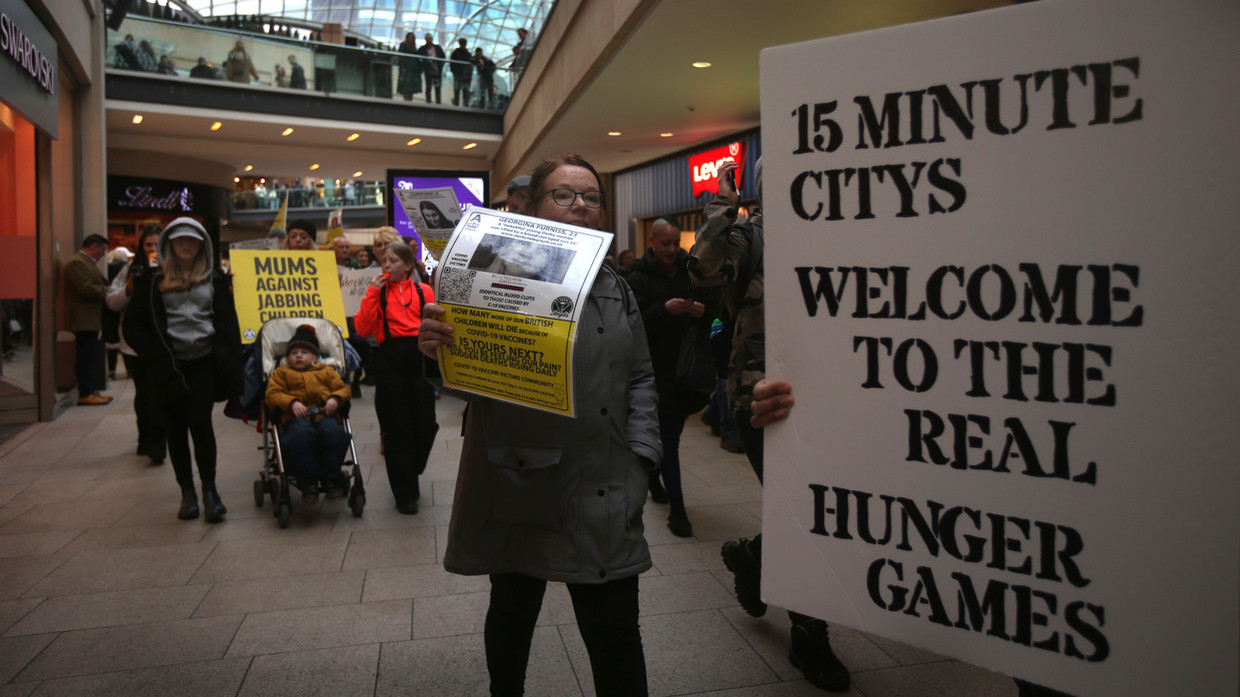In an effort to make towns more user- and eco-friendly, urban planners have unveiled the ’15-minute city,’ which hopes to keep residents close to home to battle climate change. But will this plan open the door to greater restrictions?
More than 2,000 protesters went out into the streets of Oxford, England earlier this month to express their hostility to the controversial concept of the 15-minute city, which has already been quietly unveiled in a number of major cities, including Barcelona, Melbourne, Paris and Milan.
Centered on the work of the French-Colombian urbanist Carlos Moreno, 15-minute cities are designed so that human necessities and services, like shopping, work, education, and healthcare are accessible with a short bike ride or walk from one’s front door. Such a city is divided into neighborhoods or zones, and local residents have little to no need to ever travel outside their immediate surroundings. When necessary, such trips can be taken via public transport or ring roads, keeping private cars’ harmful emissions into the city air at a minimum.
At first glance, it seems hard to argue with this proposal. After all, most people at one time or another have found themselves cursing at automobiles, maybe even chasing after them with a clenched fist (as an Australian friend of mine was prone to do when the cars didn’t stop for him in the crosswalks), wishing that the contraptions would just disappear.
In fact, something like that happened recently in the center of Moscow when the local government converted several lengthy streets around Red Square to pedestrian traffic only. The results have been spectacular. Along spacious roads once reserved for the fire-breathing machines, young people ride electric scooters, kids run without fear of becoming roadkill, and diners enjoy casual meals on patios minus vehicular noise and pollution. Meanwhile, the businesses do not seem negatively affected by the change. In fact, they seem to be flourishing like never before. So where exactly is the problem?
It seems that much of the skepticism and even paranoia about 15-minute cities stems from recent history, particularly humanity’s experience with the Covid pandemic and the restrictive methods that some world leaders chose for dealing with it. What started off as “15 days of lockdowns to flatten the curve” of the disease with a survival rate above 95%, turned into what many feel was a marathon in prison living. These skeptics now see 15-minute cities as a continuation of the dreaded ‘Great Reset’, a part of the unsettling formula of ‘You’ll own nothing and you’ll be happy.’ They view the idea of renouncing at-will car travel as something akin to “eating bugs”, which is already being promoted as a way to mitigate climate change. And they are asking: can people who promote such ideas be trusted with regulating day-to-day city life?
To further complicate matters, the very idea that climate change is a problem that must be fought at all costs is an issue that seems to be as controversial as the great debate over abortion or gun control in the US. Some people, many of them on the political right, see this environmentalism as nothing more than an excuse for exerting more government control over people. Besides, the 15-minute city’s ability to help the environment has itself been called into question.
During the Oxford protest, one of the speakers, a 12-year-old girl named Jasmine, provided an imaginary scenario: “Let’s say my friend lives in Zone 3 and I’m in Zone 1. If, for example, I went to my friend’s house in Zone 3. My parents normally come and pick me up in their car, it only takes 10 minutes. So does that mean that they’d have to go around the ring road and back into town again? If my mom or dad had to drive around the ring road, it would take 30 minutes, causing much more pollution and leaving a much bigger carbon footprint.”
Moreover, is it realistic to think that every material good and service will always be readily accessible by a 15-minute bicycle ride or casual stroll? After all, what government bureaucrats promise and what they ultimately provide seldom align. And let’s not forget that business failures happen on a regular basis and often with little notice. Will residents of Zone 1, for example, be forced to pay fines in the event they must travel to Zone 5 for essential products, like food, medicine and even water in the event of unexpected shortfalls?
Even if a self-contained neighborhood is ultimately able to maintain stable access to all the wants and needs of its residents, opponents of the idea have gone so far as to compare it to a gulag. They feel the 15-minute city would deprive them of the freedom of choice to leave their neighborhoods and venture to other businesses, schools, and health services without having to fork over money, time and nerves for the privilege.
“The idea that neighborhoods should be walkable is lovely,” Dr. Jordan Peterson commented over Twitter. “The idea that idiot tyrannical bureaucrats can decide by fiat where you're ‘allowed’ to drive is perhaps the worst imaginable perversion of that idea - and, make no mistake, it's part of a well-documented plan.”
Additionally, there are other socio-economic questions regarding equal opportunity, privilege, and even race. Nobody has been able to predict the consequences of imposing travel restrictions on more marginalized consumers who lack quality services in their poorer neighborhoods, and must now pay more to access them at a much greater distance.
Oxford’s 15-minute-city plans themselves do not actually include traffic restrictions or fines, instead focusing on making the scheme workable by ensuring that residents have access to everything they need. This includes boosting local retail, improving delivery services and other, equally benevolent measures with no encroachment on personal freedoms. Given this, the detractors of the 15-minute city have been dubbed conspiracy theorists.
However, Oxfordshire City Council also has a separate plan, a set of traffic-reducing measures that will go into trial mode next year. Under this plan, residents will not be allowed to drive on some city streets for most of the day unless they have a 100-day permit. They are encouraged to instead use the ring road or public transport. Traffic cameras will monitor compliance and fines will be imposed for violations.
The aforementioned ‘conspiracy theorists’ in Oxford have been accused of conflating the two plans to make the idea of the 15-minute city seem more ominous than it is. But their concerns are justified by the power creep they’ve seen during and after the Covid-related lockdowns – where we now know that digital tracking measures have been used for more than just reducing the spread of the virus.
Back in 1986, former US president Ronald Reagan famously told a group of journalists, "The nine most terrifying words in the English language are: I'm from the government, and I'm here to help." Those protesting the idea of 15-minute cities believe they need to get a foot in the door before the power creep actually does start encroaching on personal freedoms – which they now feel is the inevitable outcome.
The statements, views and opinions expressed in this column are solely those of the author and do not necessarily represent those of RT.



